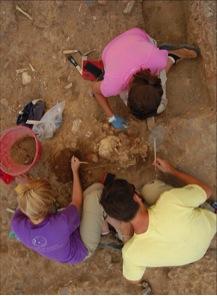
Field School students excavate human remains buried in the post-medieval churchyard at Badia Pozzeveri. Photo courtesy of Clark Spencer Larsen
SAN JOSE, Calif. — They may not have much to say, but skeletons excavated in Northern Italy could provide a trove of information and a novel approach to studying disease.
Well-preserved remains found in the massive cemetery surrounding a monastery in the Tuscan village of Badia Pozzeveri could reveal clues about bacterial epidemics such as cholera.
“We’re interested in a new sort of approach of understanding disease by looking at the ancient DNA of the pathogens,” said Clark Spencer Larsen, an anthropologist at The Ohio State University, during a symposium at the American Association for the Advancement of Science annual meeting in San Jose, Calif.
Larsen and his team study the skeletons in this cemetery so they can understand how cholera affected people in the past, which could, in turn, give insight into how to prevent modern outbreaks.
Created over a vast time frame, starting in the early medieval era through the Renaissance up until the mid-20th century, the monastery’s cemeteries serve as rich sources of information about life and death over those periods.
“Basically, it’s one big cemetery surrounding this structure, consisting of hundreds, if not thousands, of individual burials over a period of about a thousand years,” said Larsen, whose team includes colleagues from the University of Pisa and Tuscan locals.
One section of this Thousand Year Cemetery was reserved for people who had succumbed to cholera, which felled thousands in the mid-19th century. Back then, one method thought to curb the spread of the disease was to pour a lime-based liquid over the bodies of those who had died from it.
“It didn’t work very well, but they tried.” Larsen said.
Still, there were some unexpected benefits to modern archaeology. The lime acted as a seal, preserving the bodies inside. In fact, according to Larsen, the cemetery contains the best-preserved bones of people who died of cholera. Larsen surmised that Vibrio cholera, the bacterium that causes cholera, might also have been preserved within the graves.
Analysis of numerous soil samples from the burial sites has so far not revealed any V. cholera DNA. But improved technology could soon make it possible to find and sequence such DNA, providing a portrait of the pathogen and a glimpse into its evolution over time.
“What we’re trying to do is characterize what life was like in the medieval period in this setting and also look at the relationships of human and diseases in a highly dynamic setting,” Larsen said. “We think of this region and the people … as being static, but it was a day to day existence in a changing environment and they were adapting to these circumstances.”
Anya Gruber is a junior at Smith College majoring in art history and archaeology. She is the news editor of the Smith College Sophian and a contributing writer for the Cohasset Mariner. Reach her at aegruber@smith.edu.


